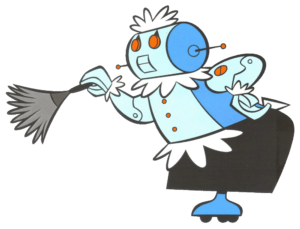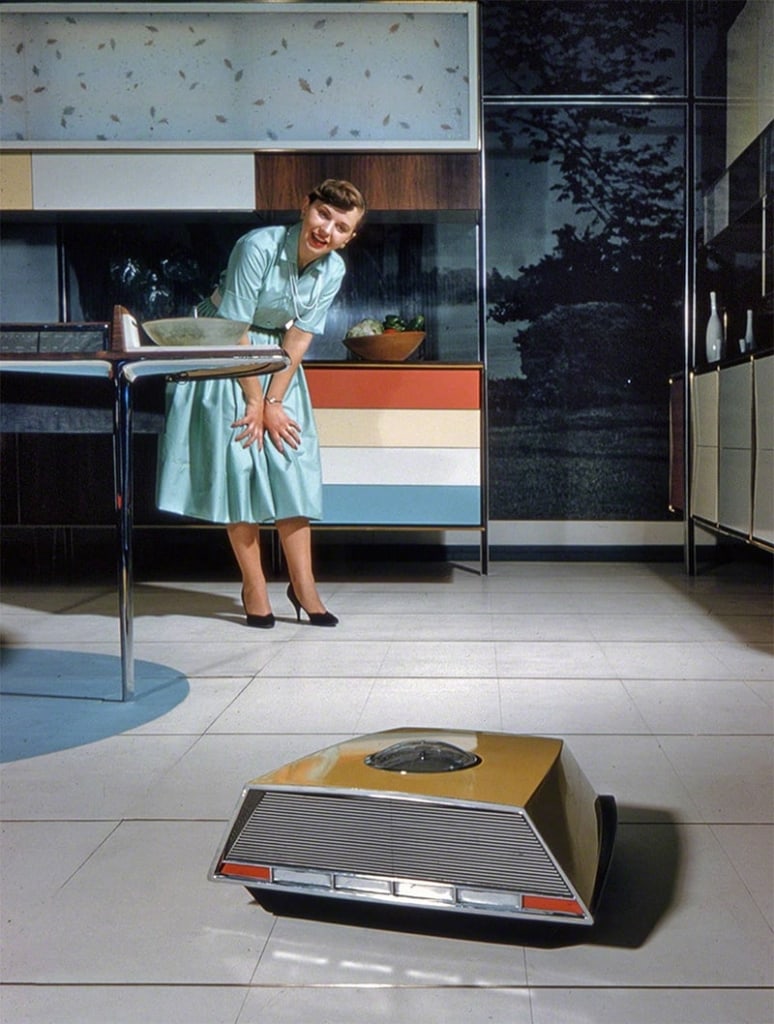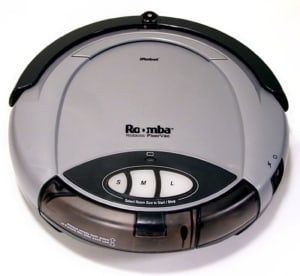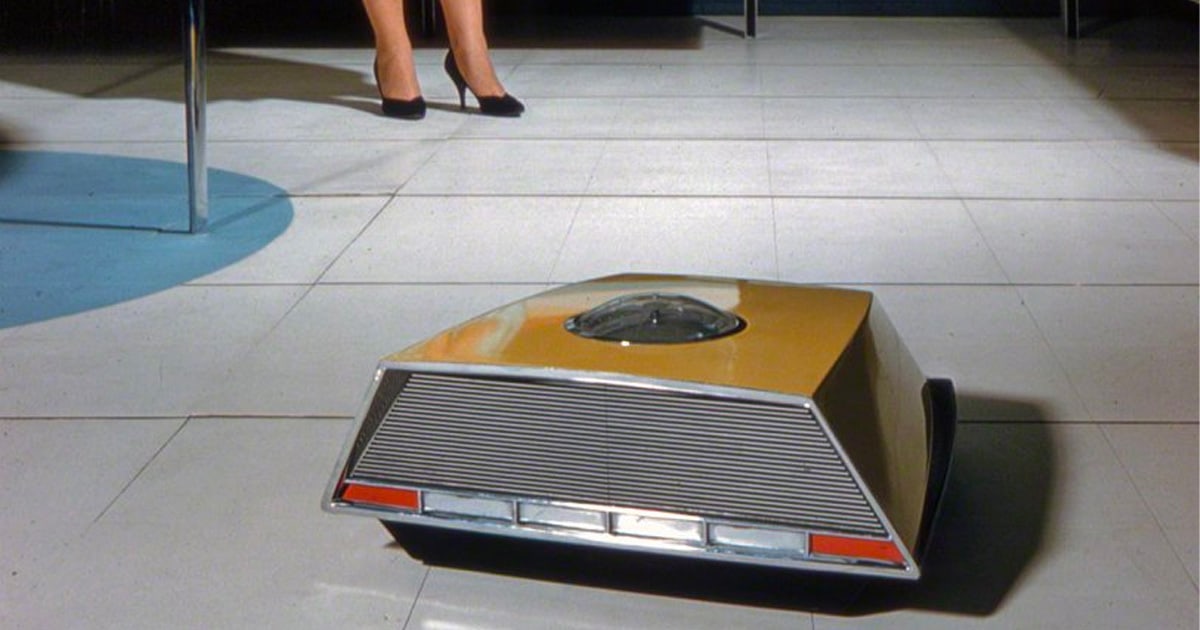The idea of having a robot vacuum that can clean a home isn’t new. In popular culture, one of the most recognizable and memorable is Rosey, a character in the once-futuristic “The Jetsons” cartoon. The first episode of The Jetsons’ first season in 1962 was even called “Rosey the Robot.”

Rosey was an idea that was far more advanced and capable than the robot vacuums we have today, some 60 years later. For example, that robot also served as a maid and housekeeper.
Over the years however, experiments have been leading to the development of various household cleaning machines, or robots, and the first robot vacuum that looks and functions as we know them now was released in 1996.
That first robot vacuum was a big step, but far from the highly advanced robot vacuums we review today.
The first patented robot vacuum concept (1956)
Donald G. Moore’s robot floor cleaner patent
The first robot vacuum patent was filed by the American engineer Donald G. Moore, and his concept is remarkably like today’s robot vacuum cleaners. The “robot floor cleaner” was controlled by a single button that sent the robot off on a pre-programmed path to clean a room. The concept was never commercialized.
Another interesting aspect of Moore’s robot was that it was a single robot that vacuumed and mopped floors, a prediction that hasn’t come to fruition until quite recently.
50 years from concept to reality
Roborock perfected the 2-in-1, vacuuming and mopping robot vacuum that Donald G. Moore envisioned in the 1950s. Premium models, like the Roborock S7 MaxV Ultra, go beyond Moore, incorporating charging stations that can empty the robot’s bin, clean it’s mopping pads, and refill the robot’s onboard water tank.
Not long after Moore’s patent, the RCA Whirlpool Miracle Kitchen was on display in Moscow at the height of the Cold War, in July of 1959. It was memorialized as the scene of a historic exchange between Soviet Premier Nikita Khrushchev and Richard Nixon, then the Vice President of the United States. Their exchange and the press that followed exemplified the philosophical differences between styles of government the two nations held.

Among the American gadgetry on display was a mockup of a robot vacuum cleaner which was said to be coming soon to American homes. “Soon” came nearly 40 years later.
Notable robot vacuums in history
Electrolux Trilobite (1996)
The first consumer “Robotic Vacuum Cleaner”
The first commercially available robot vacuum was called the “Trilobite.” Using a set of sensors and a simple control system to navigate around a room, the Trilobite would vacuum up dirt and debris.
We did a video about the Electrolux Trilobite in 2020 which can be viewed below.
The Trilobite struggled with navigation and, in turn, vacuuming efficiently. While the Electrolux innovation was ultimately discontinued, the Trilobite sparked consumers’ interest, and the consumer robot vacuum industry was born.
iRobot Roomba (2002)
The first commercially successful robot vacuum
iRobot was formed in 1990 by three roboticists from the Massachusetts Institute of Technology (MIT). The company’s focus was two-fold: domestic robots and military robots. Six years after the appearance of the Trilobite, iRobot released its first Roomba robot vacuum.

The team at iRobot incorporated a variety of sensors and software into the Roomba. The result was a robot vacuum that was more careful and capable than its predecessor, the Trilobite.
For example, the Roomba could detect the presence of dirt on the floor, and it had a cliff sensor, also known as a drop sensor, which prevented it from driving off staircases or landings between floors.
iRobot’s Roomba was a success and proved to be just the beginning of a constant cadence of technological advances from iRobot. More than twenty years later, iRobot is still manufacturing robots under the Roomba name, albeit far more sophisticated models.
Dyson DC06 (2000) and 360 Eye (2014)
Robot vacuum success eludes technologically savvy Dyson
Dyson made two well-known runs at the robot vacuum market. The first was with a model called the Dyson DC06. That model, the first with a Dyson digital motor, only made it as far as home trials and was never sold to the general public.
The successor to the DC06 was the Dyson 360 Eye, and this one did make it to the general public. Its name came from its two sensors, the 360-degree panoramic vision sensor and the infrared (IR) distance sensor. Those two sensors took care of the robot’s navigation, employing a systematic cleaning pattern.
In 2019 the 360 Eye was followed by an upgraded version, the Heurist. Navigation was improved with the Heurist, and an LED light improved its ability to clean in the dark.
For all their financial investment and engineering efforts however, Dyson has yet to establish a firm foothold in the robot vacuum industry, a stark contrast to their other successes. For example, Dyson cordless stick vacuums and uprights are among the best available today.
Timeline: robot vacuum history
1956
Engineer Donald G. Moore filed a patent for a “robot floor cleaner” in the United States.
1959
Engineer Donald G. Moore filed a patent for a “robot floor cleaner” in the United States.
1962
Rosie the robot, later renamed Rosey, stars in the first episode of The Jetsons.
1990
Ex-MIT engineers founded iRobot.
1996
Electrolux releases the first commercially-available robot vacuum, the Trilobite.
2001
LG releases the Roboking robot vacuum, also marketed as Hom-Bot.
2002
iRobot releases the first widely accepted and successful robot vacuum, the Roomba.
2004
Hoover releases the Friendly Vac, a robot vacuum weighing in at a very heavy 23 pounds.
2005
iRobot launches the Scuba, a robotic mop that is intended to complement the Roomba.
2005
iRobot successfully settles a patent infringement case against Urus and Koolatron, effectively ending the future of the Koolvac robot vacuum, deemed to be a knock-off of iRobot’s Roomba.
2010
Neato Robotics launches the XV-11, the first robot vacuum with laser-based mapping.
2015
iRobot releases the first robot vacuum that connects to a home’s WiFi network.
2016
Eufy enters the robot vacuum market with the RoboVac.
2020
iRobot states that 20% of vacuums are robot vacuums.
2022
Amazon announces it will acquire iRobot.
Promotional video for the RCA Whirlpool Miracle Kitchen
The robot vacuum makes its first appearance toward the end of the video. To see that clip specifically, fast forward to 11:50.
Modern robot vacuums
Precise navigation, effective and efficient cleaning, and self-maintenance
Robot vacuums are now widely available and a fairly common household appliance. With the integration of Artificial Intelligence (AI) and machine learning, the latest models can now adapt to the layout of a room, avoid obstacles, be controlled with smartphones, and interact with voice assistants.
Robot vacuum and mop manufacturers
There’s a growing list of manufacturers that engineer and sell robot vacuums. Some are well-known brands, while others are recent entrants into the market. Brands that readily come to mind include the following:
- Bobsweep
- Ecovacs
- Eufy
- iLife
- iRobot
- Narwal
- Neato
- Roborock
- Samsung
- Shark
A growing market fueling innovation
The robot vacuum market is expected to grow to $7.83 billion by 2026 with a compound annual growth rate of 6.9%. That number is up from $5.59 billion in 2021. As brands vie for a piece of the growing market, we expect innovation to continue to grow.
We are anticipating far better robot vacuums at all price points – from budget and mid-range to premium. Newer budget robot vacuum cleaner models will adopt technology that was only seen in premium robot vacuums just a few years ago. And on the premium side, expect longer battery life, more suction power, premium docks being the norm, and continued improvements with AI and obstacle recognition and avoidance.
